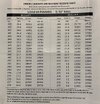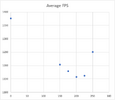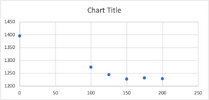JimGnitecki
Member
- Joined
- Mar 28, 2010
- Messages
- 1,258
I had great accuracy with a specific Lee bullet mold and a Lead alloy with BHN = 10, in my Pedersoli Sharps .45-70 replica, shooting a 485g bullet when shooting at 100 yards. But, that bullet design became unstable enough by 150 meters = 164 yards that it would not group at all.
With the new slightly heavier bullet mold I am using now (497g and very slightly different ogive), versus the older mold, the bullets are stable now at ranges beyond 100 yards. The new bullets do group well at 164 yards, but not PROPORTIONATELY as well as the older bullets did at 100 yards. i.e. Accuracy is inferior on the new bullets on an MOA basis.
The bullet alloy I have been using is wheel weight based, with 1% more Tin added, resulting in that BHN = 10, which is a relatively soft bullet. I had used the BHN = 10 alloy successfully at 100 yards with loads whose peak pressure was 19,000 psi or lower. But now, I have realized that avoiding transonic bullet velocity ranges is more important than I knew, and have stepped up velocity to a 1350 to 1375 fps range, and that velocity range is supposedly (per load tables) generating peak pressures as high as 28,000 psi.
I ran out of wheel weights, and so have switched to using an alloy, made from pure Lead, Rotometals Super Hard ingot, and pure Tin. I mixed these to generate an alloy whose BHN = 12.5. I want to see if the BHN = 12.5 will improve the accuracy. Since I am powder coating versus using conventional lubricants, I have not been getting any barrel leading at all with BHN = 10. But, Richard Lee devoted an entire chapter in "Modern Reloading" to how BHN is important in optimizing accuracy, and how bullet BHN should be "matched" to peak pressure, with peak pressure being about 90% of bullet strength.

On that basis, the BHN =10 alloy I have been using is "way too soft", even though my use of powder coating versus conventional lubrication gives me a lot more leeway on bullet hardness.
But if Richard Lee was correct in his stance, then BHN = 12.5 is still not going to be enough of an increase in hardness given the load that I am using now. The Richard Lee data in Modern Reloading seems to indicate that a BHN as high as 22 might be ideal.
Since I already have made a small test batch of bullets using the BHN = 12.5 alloy, I am planning to do some range testing to see if accuracy remains the same or gets better. If it gets better, which the Richard Lee experimentation predicts it will, I will next test an even higher BHN alloy, and work my way upward.
But, I have consistently read on online forums that most of the 45-70 replica "buffalo rifles", and Pedersoli rifles specifically, normally do not require BHNs anywhere near that high. Is this because most buffalo rifles are being shot at lower velocities with low peak pressures (much lower than the 28,000 psi the load tables say I am at when shooting a 500g bullet at 1350 to 1375 fps)? Or, is it because conventional cast bullet lubricants simply don't work well at 1400 fps velocities and so buffalo rifle shooters simply don't try higher pressure loads?
Any of you out there shooting 45-70 cast bullets with high BHN?
Jim G
With the new slightly heavier bullet mold I am using now (497g and very slightly different ogive), versus the older mold, the bullets are stable now at ranges beyond 100 yards. The new bullets do group well at 164 yards, but not PROPORTIONATELY as well as the older bullets did at 100 yards. i.e. Accuracy is inferior on the new bullets on an MOA basis.
The bullet alloy I have been using is wheel weight based, with 1% more Tin added, resulting in that BHN = 10, which is a relatively soft bullet. I had used the BHN = 10 alloy successfully at 100 yards with loads whose peak pressure was 19,000 psi or lower. But now, I have realized that avoiding transonic bullet velocity ranges is more important than I knew, and have stepped up velocity to a 1350 to 1375 fps range, and that velocity range is supposedly (per load tables) generating peak pressures as high as 28,000 psi.
I ran out of wheel weights, and so have switched to using an alloy, made from pure Lead, Rotometals Super Hard ingot, and pure Tin. I mixed these to generate an alloy whose BHN = 12.5. I want to see if the BHN = 12.5 will improve the accuracy. Since I am powder coating versus using conventional lubricants, I have not been getting any barrel leading at all with BHN = 10. But, Richard Lee devoted an entire chapter in "Modern Reloading" to how BHN is important in optimizing accuracy, and how bullet BHN should be "matched" to peak pressure, with peak pressure being about 90% of bullet strength.

On that basis, the BHN =10 alloy I have been using is "way too soft", even though my use of powder coating versus conventional lubrication gives me a lot more leeway on bullet hardness.
But if Richard Lee was correct in his stance, then BHN = 12.5 is still not going to be enough of an increase in hardness given the load that I am using now. The Richard Lee data in Modern Reloading seems to indicate that a BHN as high as 22 might be ideal.
Since I already have made a small test batch of bullets using the BHN = 12.5 alloy, I am planning to do some range testing to see if accuracy remains the same or gets better. If it gets better, which the Richard Lee experimentation predicts it will, I will next test an even higher BHN alloy, and work my way upward.
But, I have consistently read on online forums that most of the 45-70 replica "buffalo rifles", and Pedersoli rifles specifically, normally do not require BHNs anywhere near that high. Is this because most buffalo rifles are being shot at lower velocities with low peak pressures (much lower than the 28,000 psi the load tables say I am at when shooting a 500g bullet at 1350 to 1375 fps)? Or, is it because conventional cast bullet lubricants simply don't work well at 1400 fps velocities and so buffalo rifle shooters simply don't try higher pressure loads?
Any of you out there shooting 45-70 cast bullets with high BHN?
Jim G




